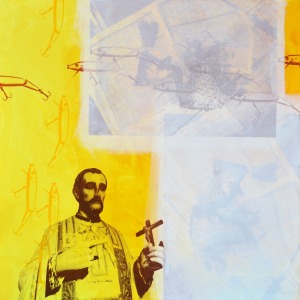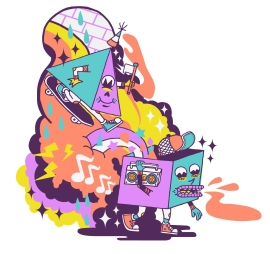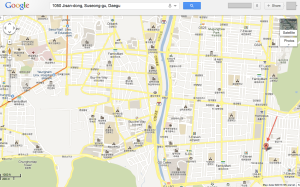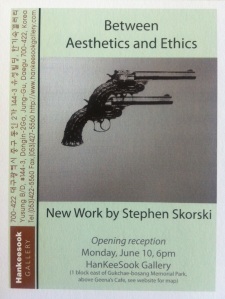On Saturday, I visited Stephen Skorski’s exhibit “Between Aesthetics and Ethics” at the HanKeeSook Gallery. The series was full of color and crisp images that gently coaxed the viewer into investigating the dichotomy of ethics vs. beauty and how that struggle is reflected in the social issues of our time. How do we, as a society, glaze over the problematic visuals of homelessness, prostitution, gun control, and the conflicts that arise out of religion? While opening the doors to these questions, Skorski’s work lets the viewer contemplate personally, without directing or suggesting any particular path for the mind to follow – indeed, just as the artist himself intended.
The following are highlights from my interview with Skorski:
Kita Mendolia: So I guess just a basic starting point: how long have you been creating art? When did that start?
Stephen Skorski: Well, I’ve only been working with painting and screen-printing for a short time. But, with architecture you’re constantly sketching and then primarily working in three dimensions. It’s different than this, but the goals are the same. So in this style and format, a little over a year.
KM: How do you feel about the medium switch moving from three-dimensional models to a very flat, two dimensional surface?
SS: I don’t think about it too much in terms of 2-D or 3-D. What I like about it is the fact that you’re in total control. In architecture, you’re not. There are just so many other factors- client, building codes, budgets, site…
KM: Gravity…
SS: …Right. You name it. But with this, when I first started doing it, I thought it would be immediate. But it’s not. Some [pieces] take a long time. So it’s not immediate gratification. But I do like that you’re in total control of what you’re working with.
KM: What inspires you? Are you inspired by the people and things around you or is it more of an internal inspiration?
SS: I’m not sure what inspires anybody to do anything. But in terms of what my interest are, it’s what I see around me. I think the way that people interact with each other, interact with the world, [and] interact with themselves is a fascinating thing to witness. So, that’s what motivates me – Being able to document that in some way and put images together that remind me of what [I see] and then possibly make sense of it… Again I don’t know if that inspires me to be creative but, that’s what’s interesting about it to me.
KM: This particular series, did you think of them as cohesive single work, or are they a collection of pieces that have a similar vein?
SS: I would say it’s a related group of thoughts. Obviously some have much more of a relationship to others. But that being said I certainly thought about it as a show. Technically, I experimented with related techniques and tried similar ideas in different ways in different pieces.
…
KM: Could you explain your choice of title a little bit?
SS: When I’m working on a painting, there is always a desire to create something that is visually appealing. But on the other hand it is much more important to me to think about ideas that are related to larger issues like morality and ethics and how you live your life and what kind of decisions you make. So I tried to navigate that line —I’m not entirely focused on aesthetics and I’m not solely concerned with ethics. I like to create in the area in between.
KM: I noticed that all of the pieces call out society on those darker, seedier things that we would rather not think about.
SS: Yes, that’s what’s fun about it. For the most part, I don’t think things are black and white. There’s a lot of grey. So, I tried to be non-judgmental in all of it. I just don’t know myself, in many cases. I mean, you kind of have an idea and you sort of trend in a direction. On the other hand, I think it becomes very dangerous when you feel so strongly about your beliefs that you say, “I’m right and you are a bad person for doing that.” So I think in most of these, I tried to balance out so you could see the good or see the bad.
KM: Leaving the choice up to the viewer rather than giving them a particular view point on the exact nature of something.
SS: Yes
….
KM: This piece Temptation. The statue was from…?
SS: A church in Macao. The fishing images are from watching my Dad in New Jersey.
KM: I was curious about this one because though you have religion in here, which is damning to temptation, there are no other traditional visuals of temptation like sex, or booze, or drugs, or … shopping. So, I was curious where you found the title for that one.
SS: I think it’s a question about religion and what religion’s role is? Is it absolutely positive? Is it absolutely negative? And the fishing lure is a play on words with the title. You could take this in different ways. What is actually tempting anybody? What is the lure? Is helpful or hurtful? Where do you turn for salvation?

…
KM: The entire collection seems to be very provocative in terms of calling people out to think about social issues, personal issues, moral issues.
SS: That was really my hope – that the work is stimulating enough that people would think about issues in a very personal way. The art that interests me is the art that lets me think and explore by myself. Because I don’t know the artist and I quite frankly don’t care what the artist thinks. I am very interested in their intentions, but their personal philosophy does not interest me. And I feel the same way about my work. I don’t expect anyone to care what I think. Why would they? They don’t know me. In this regard my thoughts are irrelevant. It doesn’t make any sense to tell people what to believe anyway. If my work raises some questions and it allows someone to discover something about themselves – great. That’s all I could hope for and to me that would be success.

**** “Between Aesthetics and Ethics” closes June 20, 2013. Find directions to the show here. More of Skorski’s work can be seen at the Bongsan Cultural Center in the group show “Matrix Tool.” The show runs from June 18 to June 23 and is located on the 3rd floor at the Bongsan Cutlural Center, 대구광영시 중구 봉산문화길77.
~ Kita Mendolia








